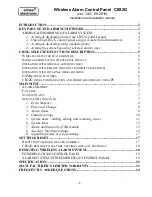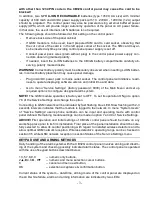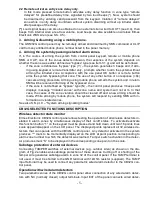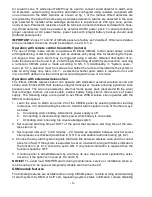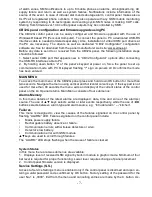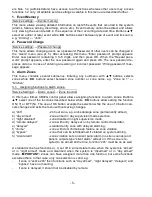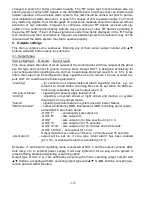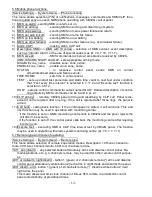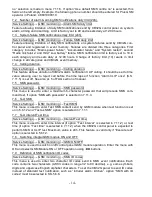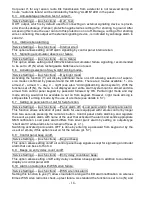
- 9 -
Examples of assigning functions to alarm zones:
Entry zone c
an be “remote delayed”, i.e. after using remote button entry delay countdown
is started. Security violation in the zone during the countdown will not generate the alarm
immediately, but after the countdown is finished. That allows user sufficient time for safe
disarming the system.
Entry zone can also be a delayed zone, i.e. when the zone is violated, the entry delay
countdown starts and the system must be disarmed before the countdown is finished. If
system is not disarmed an audible alarming sets on.
The
“chime type” zone which often is also a “delayed” or “remote delayed” zone, gener-
ates two beeps sound signal on every violation of the zone (e.g. notifying customer en-
trance to a store).
A basement zone can be “day armed” but it cannot be “active 24h” simultaneously.
A
„bypass” zone type allows arming the alarm while intentionally leaving a window
opened protected by CTX
detector (see “System Arming”).
3.2. Zone name.
Service settings
→ Alarm zones → Zone name
This menu allows alarm zones used in the system to have user defined up to 16-character
name, e.g.: kitchen, living room, office, Mark’s Room, etc. Uppercase and lowercase letters,
digits and the following characters are accepted: spac
e, “-,./”.
Buttons ◄► select the successive letters of the name while the ▲▼ buttons browse charac-
ter table. Accept name with OK button. Use C button to exit the menu.
3.3. Learning wireless detectors to control panel.
Service settings
→ Alarm zones → Learning detectors
In this menu use the ▲▼ buttons to select zone number, and the ◄► buttons to toggle be-
tween displaying the zone number and zone na
me, e.g.: zone 1 ↔ kitchen. OK button accepts
all selections. If detector is already learned to selected zone,
“OK-remove” prompt appears.
Pressing OK button deletes detector in the zone. If
zone is vacant, the “OK-learn” will appear
on the LCD. Pressing OK button starts learning detector to the zone. In response to the
“Awaiting trans. 1” and “Awaiting trans. 2” prompts, two successive alarm transmissions must
be triggered from detector
(*)
.
C
orrect learning will be followed by “OK-correct” message. Er-
rors are signalled
by 3 beeps and “Program error” message. The use of C button exits the
menu.
(*)
For detailed information on how to learn any Elmes detector to Elmes CB32G control pan-
el please refer to instruction manual of the detector.
3.4. Zone disabling.
Service settings
→ Alarm zones → Zone disabling
Buttons ◄► disable and enable zone selected with ▲▼ buttons. Accept selection with OK
button. Exit the menu with C button.
3.5. Radio range test.
Service settings
→ Alarm zones → RF range test
To assess the level of radio reception of signals received from detectors, the most distant d e-
tectors in particular, the CB32G
panel is provided with “RF range test” function allowing the
received signal level to be displayed on 16-point bar graph scale of LCD.
After entering this menu all RF signals in the 433.92MHz radio band will be displayed in form
of bar graph. The detectors should be triggered to send alarm transmissions. The longer the
distance of the detector from the control panel, or the greater difficulty in radio waves prop a-
gation, the lower the level of received signals and the length of the displayed bar graph. If the
number of displayed fields is lower than three it should be assumed that this connection does
not guarantee reliable alarming. The location of detectors or the control panel should be

